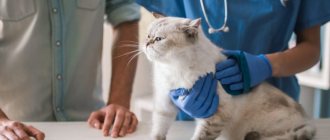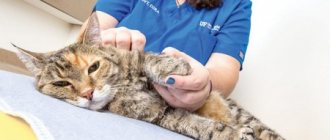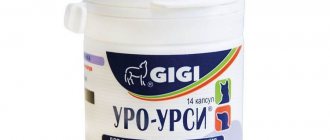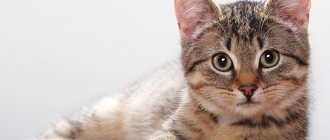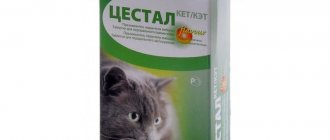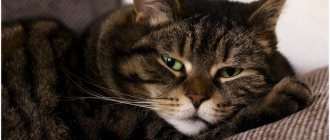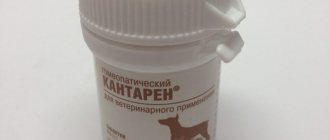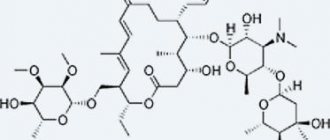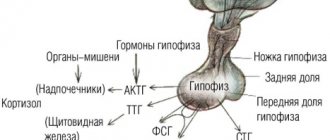Home » Useful Information
Toxic substances accumulate in the animal’s liver, which disrupt the functioning of this internal organ. This situation occurs most often after illness, and Hepatovet is used to eliminate the problem. This veterinary drug is a hepatoprotector; its action is aimed at improving the general condition of the liver, cleansing it and accelerating the regeneration of damaged cells. The medicine also helps to cope with intoxication of the body.
This medicine is produced by the Russian company Api-San. Before starting use, you should familiarize yourself with the composition of Hepatovet for cats, instructions for use of the drug, its dosage, contraindications, analogues and possible side effects.
- 2 Purpose and form of release
- 3 Contraindications
- 4 Instructions for use
4.1 Dosage
Description of the drug Gepatovet
Hepatovet is a veterinary drug that is used to improve the condition of the liver and its detoxification. This hepatotropic medicine is produced by the Russian organization NPO Api-San LLC (Moscow region).
Composition of the drug
The composition of 1 ml of medicine includes the following components:
- essential phospholipids - 60 mg;
- methionine - 100 mg;
- L-ornithine - 50 mg;
- milk thistle extract - 15 mg;
- immortelle herb - 15 mg;
- potassium sorbate - 1.5 mg;
- sodium benzoate - 1.5 mg;
- sodium carboxymethylcellulose - 1.5 mg;
- Tween-80 - 6 mg;
- distilled water - up to 1 ml.
Due to the combination of active ingredients, the non-proprietary name of Hepatovet is Lecithin + methionine + ornithine + milk thistle + immortelle
Release form of the drug
Gepatovet is available in the form of a cloudy orange suspension for oral administration. The drug is packaged in brown glass bottles of 25 or 35 milliliters. Each bottle has a threaded plastic cap and is packaged in a cardboard box. On its front side there is a face of a gray cat, as well as the inscriptions:
- name of the manufacturer Api-San;
- name of the drug;
- prescription of the drug;
- nominal volume of the bottle.
All names (except Api-San) are white on an orange background. The composition, storage conditions and expiration date are indicated on the side of the box. There is a barcode at the bottom, and on the lid there is the date and series of production.
Storage conditions for the medicine
The manufacturer recommends storing Hepatovet in its original packaging in a place protected from moisture, heat and direct sunlight. The cat owner should immediately ensure that children and pets do not have access to the drug. Some people place Hepatovet in the refrigerator, since the optimal storage temperature cannot be above +25 °C and below +2 °C.
The shelf life of the drug is 2 years from the date of production. But if you open the bottle, the seal of the package is broken - in this case, the shelf life is reduced to 21 days. A drug that has expired must be disposed of. The bottle cannot be used for household purposes.
Do not leave the medicine in open places - it must be stored in a medicine cabinet or refrigerator
Shelf life, precautions
The veterinary drug may be stored:
- 3 years from the date of manufacture - for bottles with a sealed factory stopper;
- 3 weeks – after opening.
The medicine should be stored:
- in the original bottle;
- in a place protected from direct sunlight;
- at temperatures from 5 to 25 degrees.
Bottles should not be placed near pet food, food or in places accessible to children.
Reuse of empty glass containers is not allowed; they are thrown away with household waste.
When working with a veterinary product, follow the hygiene and safety rules:
- in case of unintentional contact of liquid with skin or mucous membranes, they are washed abundantly with water;
- people with confirmed hypersensitivity to the components completely exclude contact of the product with the skin or membranes of the eye.
If allergic reactions are detected or the drug enters the human body, contact a medical institution, taking with you the instructions, label or box of the drug.
apicenna.ru
Indications for use of the drug
Hepatovet for cats is prescribed in the following cases:
- for acute and chronic liver diseases (hepatitis, lipidosis, cirrhosis, etc.);
- as an adjuvant in the treatment of helminthic infestations;
- during the use of tablets that have a toxic effect on the liver (for example, during treatment of cancer);
- in the presence of infections that are characterized by intoxication of the body.
Hepatovet is a complex drug that has a pronounced effect, so it is not recommended to use it without consulting a veterinarian. If it is not possible to take your cat to the clinic, at least call the veterinarian on duty.
I have long made it a habit to keep the veterinary clinic’s business card in a visible place. One of them lies right in the first aid kit with cat medicines. And the second one (with the veterinarian’s mobile phone number) hangs on the refrigerator. This is also very convenient because noticing the business card every day makes it difficult to forget, for example, about the next vaccination. By the way, you can keep the veterinarian’s notes right there.
Principles of feeding and diet for hepatopathy
Dietary nutrition for hepatopathy is selected individually - based on the patient’s tests. Despite this, some rules are the same for everyone:
- Too fatty foods and fast carbohydrates must be removed from the diet.
- The number of feedings is increased, and the usual portions, on the contrary, are reduced. This allows you to relieve the gastrointestinal tract and avoid prolonged fasting.
- All food is served in grated or ground form, and when heating it, it is oriented at room temperature.
To improve immunity, it is recommended that the animal take a course of vitamins and minerals that are lacking in the body. When feeding naturally, the list of permitted products includes:
- rice and oatmeal porridges or decoctions;
- boiled sea fish and lean meat, as well as light broths based on them;
- fermented milk products with a low fat content;
- boiled, steamed or baked vegetables.
For animals eating dry food, a transition to veterinary lines intended for the treatment of gastrointestinal diseases is provided. They are produced by Royal Canin, Purina Pro Plan, Hill's and other well-known manufacturers.
Mechanism of action of the drug
The complex of flavonoids, amino acids and essential phospholipids contained in the drug has a beneficial effect on the condition of the organ as a whole. The active substances stimulate the detoxification function of the liver and can accelerate the restoration of its cells.
Milk thistle’s ability to treat the liver has been known for a long time - most natural hepatoprotectors are based on its extract
The liver consists of 60–80% hepatocytes. If these cells become damaged or poisoned, the liver stops functioning properly. Hepatocytes are not prone to active regeneration, and the Hepatovet formula is designed in such a way as to restore and preserve these cells.
Hepatovet improves the condition of the liver, especially the organ’s ability to bind and remove toxins, preserves and restores the structure of liver cells, accelerates the process of restoration of already damaged hepatocytes, etc.
Natalya, forum user, veterinarian
https://www.babyblog.ru/community/post/petsandcats/1717171
conclusions
Hepatovet for cats is an inexpensive, domestically produced drug, consisting of high-quality components, which does not have an impressive list of contraindications. This hepatoprotector will help in the treatment of liver diseases and intoxication of the body, and will improve the condition of the animal.
The owners note that the cats began to feel better, look more cheerful, their appetite returned, the volume of the abdomen in the liver area decreased, flatulence and vomiting stopped, food began to be better absorbed, and the results of liver tests returned to normal.
Reviews from most veterinarians are favorable to Hepatovet, but some of them are inclined to believe that this is not a drug from the medicinal group, but a biologically active food supplement.
Important! Hepatovet, developed for dogs, is absolutely not suitable for treating cats and can even be harmful to health.
Features of the use of Hepatovet in cats
Hepatovet, like any other suspension, tends to “settle”, so the medicine must be shaken well before use. The suspension can only be given orally. In general, Hepatovet smells like raw beef liver, so most cats accept it willingly. However, the manufacturer has provided for cases when an animal refuses to swallow an incomprehensible liquid:
- you can use a spoon or syringe and inject the suspension directly into the mouth (closer to the throat);
- It is possible to add the required dose to wet food.
My sister has a cat, Donut. A couple of years ago he was diagnosed with urolithiasis. By hook or by crook, the cat was cured, although he had to be put on a diet for chronic renal failure. Closer to recovery, the veterinarian prescribed Hepatovet. The suspension was supposed to mitigate the undesirable effects of drugs on the liver. But Donut refused to swallow it. To “shove” a single dose into the pet, they bought him delicious wet food. The cat quickly realized that this was a trick. Attempts to pour the medicine with a spoon ended in a dirty cat's chin and scratches on the hands of the head of the family. Judging by our experience, only a syringe helps.
Video: how to give a cat a slurry to drink
Table: dosage selection
| Cat body weight | Single dose | Daily dose |
| Kittens and cats up to 3 kg | 1 ml | up to 3 ml |
| Animals from 3 to 6 kg | 2 ml | up to 6 ml |
| Big cats from 7 kg | 3 ml | 7–9 ml |
Treatment regimen
Typically, the daily dose of Hepatovet is divided into 2-3 doses (for example, in the morning, at lunch and in the evening). Treatment can be long - up to 5 weeks . The shortest duration of therapy is 21 days. If necessary, the course can be repeated after 15–20 days. Before doing this, it is necessary to consult a veterinarian - perhaps the drug should be replaced.
Features of use in pregnant cats and kittens
The undoubted advantage of the drug Hepatovet is that it can be used to treat kittens, pregnant and lactating cats.
Pharmacological properties
The drug has the following effects on the animal’s body:
- maintaining liver function to bind and eliminate toxins;
- restoration of liver cells;
- decrease in the level of ammonia compounds in the body;
- activation of the enzyme system;
- reduction of fibrous tissue degeneration;
- active antioxidant effect;
- elimination of colic, pain, flatulence.
Essential phospholipids
prescribed for any liver dysfunction. These cellular elements successfully restore fat and water metabolism, prevent fatty degeneration of the organ, and promote the restoration of liver cells. Thanks to their work, the amount of glycogen in the body increases and protein synthesis is normalized.
L-ornithine
participates in the regeneration of organ tissue and ammonia detoxification, increases insulin production, and normalizes the acid-base balance.
Methionine
as an essential amino acid – a pronounced detoxifier. Activates the enzymatic and hormonal work of the body. Increases the content of phospholipids and reduces cholesterol levels.
Milk Thistle (extract)
has a pronounced anti-inflammatory and choleretic effect. A powerful antioxidant, restores liver cells, has a general strengthening effect on the organ.
Immortelle herb extract
reduces pain in the liver, eliminating spasms, gagging and flatulence. Improves bile secretion, reduces bile viscosity.
Limitations in use
Contraindications to the use of Hepatovet are:
- severe form of liver failure;
- epilepsy;
- intolerance to the components of the drug.
Side effects
If you use Hepatovet strictly according to the instructions and in accordance with the recommendations of the veterinarian, there will be no side effects. Some cat owners panic when the cat's salivation increases after using the medicine, but the manufacturer assures that such a reaction to the hepatoprotector is normal. This goes away without any intervention.
The only side effect may be the cat's allergy to the drug. In this case, the use of Hepatovet is stopped, and the cat is prescribed antihistamines (consultation with a specialist is needed).
Increased salivation is not a side effect
Personal prevention measures
When using a hepatoprotector, the cat owner must follow the safety rules:
- Before starting to work with the drug and after finishing, you need to wash your hands with soap;
- Only a clean spoon should be used to administer the medicine;
- if the cat's owner is allergic to any component of the medication, it is necessary to wear gloves when working;
- You can use a medical mask.
My father's side of the family passed on to me a tendency toward allergies of various kinds, so I have a special relationship with medications. However, I don’t use gloves: allergies do not affect the skin in any way, and besides, they are uncomfortable, especially when working with a cat. But I have to use a medical mask, since a reaction can occur specifically to volatile substances. If the mask breaks or becomes unusable, I use a bandage folded in several layers.
Side effects
During the initial administration of the hepatoprotector and after its discontinuation, no atypical reactions were observed.
If the instructions were followed, practically no negative manifestations were observed during treatment. Severe reactions can only occur if there is intolerance. If the pet’s condition sharply worsens after administration of the veterinary drug and/or atypical symptoms appear, therapy should be interrupted and consult a doctor immediately.
If local signs of allergy develop - rash, itching, redness - you should contact a veterinary clinic to prescribe antihistamines. The question of the advisability of further use should be decided individually.
Analogues of the drug
Hepatovet has no absolute analogue. But in pharmacies there are drugs with a similar composition and similar medicinal properties:
- Hepatojekt;
- Hepatolux;
- Heptral (human drug, but often used in veterinary medicine);
- Legaphyton 50 (Legaphyton 50);
- Kovertal;
- Carsil.
Photo gallery: similar hepatoprotectors
Hepatoject is sold in bottles of 20 or 100 ml
Hepatoprotectors in tablets are cheaper than suspensions
Heptral was developed for treating humans, but due to the lack of the necessary medicine, veterinarians sometimes prescribe it
Legafiton is quite rare, but it can be ordered from online pharmacies
Covertal is sold in bottles of different sizes (from 10 to 100 ml)
Table: comparison of analogues
| Name of hepatoprotector | Development organization | Dosage form | Indications for use | Limitations in use | Price |
| Hepatoject | "Api-San", Russia | Injection | Chronic and acute liver diseases, toxicoses and consequences of past illnesses | Sensitivity to the components of the drug | From 560 rubles for 20 ml |
| Hepatolux | Agrobioprom, Russia | Tablets, suspension | Diseases of the liver, gall bladder and biliary tract, intoxication, dehydration | Drug intolerance, hepatic encephalopathy, acute renal failure | From 240 rubles for 30 tablets |
| Heptral | Abbott Laboratories, Germany | Tablets, injection solution | Chronic and acute liver diseases of various etiologies | Sensitivity to the components of the drug | From 1400 rubles for 20 pieces |
| Legafiton 50 | Vetoquinol, France | Pills | Various liver diseases and prevention of its pathologies | Intolerance to components, severe renal failure | From 450 rubles for 24 tablets |
| Covertal | "AlexAnn", Russia | Injection | Hepatitis, gastritis, fatty degeneration and other liver pathologies | Intolerance to the drug components | From 260 rubles for 10 ml |
| Karsil | Sopharma Ad, Bulgaria | Dragee in a shell | Cirrhosis, hepatitis, intoxication and other liver diseases | Pathologies of the uterus and mammary glands, hypersensitivity to the components of the drug | From 350 rubles for 80 pieces |
Liver damage: types and main signs
Intoxication
The main symptoms of body poisoning in a cat are vomiting, diarrhea, pain, no appetite, weakness, panic in the pet, and shifty eyes. The causes of liver damage are food with dyes, ecology, apartment renovations, and poor-quality pet care items. Most often, poisoning occurs from flea bites. They transmit viral and bacterial infections and helminths to cats. Intoxication also occurs after medications, which owners can use to poison worms by giving their pet more of the drug than normal. If your pet is poisoned, you should urgently call a veterinarian. You cannot give food or feed tablets on your own.
Hepatitis: a dangerous disease
A disease that destroys liver cells and disrupts the functioning of the organ and the body as a whole. Hepatitis can be toxic and infectious. In the first case it is intoxication with poisons, in the second it is infection with a virus. The size of the liver increases, the fluffy has stomach pain on both sides. The veterinarian will prescribe a diet (without broth, meat), take tests, prescribe antibiotic therapy and a number of other mandatory medications. Treatment of hepatitis in cats does not occur quickly.
Hepatosis as a sign of dystrophic changes
The accumulation of fatty deposits in the liver manifests itself due to overeating and is a dangerous ailment that requires timely treatment.
This is a metabolic disorder in hepatocytes and fat deposition in the organ. Liver hepatosis in cats is a very terrible disease; if left untreated, the animal may die. The causes are diabetes, pancreatic dysfunction, and overfeeding. With this disease, it is often necessary to force-feed the cat through a tube, for about six months, with food high in protein, limiting the consumption of fatty animal foods. Timely help will help restore liver function. If the liver fails, urgent hospitalization will be required.
Cirrhosis is a fatal pathology
The disease is characterized by the proliferation of connective tissue, the liver stops working. The disease occurs in older cats, but rarely in kittens. Primary cirrhosis of the liver in cats is inherited; damage to the organ occurs due to toxins. Secondary appears due to viruses, helminths, liver parasites. Cirrhosis can appear against the background of long-term hepatitis or hepatosis. The disease is difficult to detect and has no early signs. Organ damage occurs quickly. Due to cirrhosis, the animal most often dies. Timely vaccination can protect your pet from illness.
If a cat's liver ruptures, urgent surgery is necessary.
Cholecystitis and its forms
Acute inflammation of the gallbladder mucosa. Bile is excreted from the liver and accumulates in the bladder. In this form, the disease progresses quickly. In the chronic stage, the disease proceeds unnoticed until yellowness of the mucous membranes and a change in the color of the stool appear. Often the acute form becomes protracted. Appears due to obstruction of the bile duct, hepatopathy, bacterial infections, bladder injuries and rupture. The cat refuses to eat, its body is not working at full capacity.
Cholangitis in cats
When the bile ducts become inflamed, the pet suffers from indigestion in which bile is involved.
Inflammation of the bile ducts, sometimes leading to their obstruction. Bile is necessary for the digestion of fats, so due to the disease the cat has digestive problems. There are three types of cholangitis:
- Neutrophilic. Liver tissue is saturated with neutrophils.
- Lymphocytic. There are a large number of lymphocytes in the tissues.
- Parasitic lesion. Microorganisms enter the liver through the digestive system, and the disease is accompanied by pancreatitis and intestinal inflammation.
Cholelithiasis
Stones appear in the bile ducts, and liver problems arise. This pathology mainly affects castrated cats and older cats. One or two stones appear, in severe cases more than a dozen. The cat's life becomes difficult, and every meal causes hepatic colic. The main factor contributing to the development of the disease is parasites (cat fluke). They feed on blood and tissues of the bile ducts. In severe cases, surgery will have to be performed. Recovery from illness does not occur immediately.
Hepatic lipidosis
A large amount of fat accumulates in the liver. One of the most serious diseases in cats. Most often, pets get sick because they lead a lazy lifestyle. Inflammation of the liver progresses quickly, liver failure, hepatopathy occurs, and in severe form hepatic encephalopathy, poor blood clotting, and pain appear. A quick diagnosis is a chance for salvation.
Liver cancer
Oncological disease of the organ is eliminated through surgery and a course of chemotherapy.
Hepatocarcinoma is the most common liver tumor. Most often, liver cancer appears in cats over the age of 8 years. Neoplasia or cancer can make itself felt at a late stage, until the neoplasms become large, the liver is significantly enlarged, and metastases occur in other organs. The symptoms are the same as other liver diseases. Basically, surgery and chemotherapy are performed to treat and eliminate pathology. The chances with this disease are low. In most cases, the cat dies, since late diagnosis will not completely get rid of the tumor.
Owner reviews
We used it 2 times a day for two weeks, it became much better: the food was digested, she became much more vibrant and even plumper.
innnnusik, forum user
https://irecommend.ru/content/pomogaet-pecheni-moei-koshki-usvaivat-pishchu
Spiders are best suited for this; they smell similar and are quite liquid. Ours was accustomed to natural medicine, and here, in the third week of treatment, problems began to arise: the cat stopped liking the taste of Hepatovet and had to use his imagination to push the medicine in. But it was worth it. After the course of treatment, the cat became more mobile, and his stomach, especially where the liver used to protrude, became smaller.
Ronda, forum user
https://otzovik.com/review_582499.html
The clinic said that cats use Hepatovet with pleasure, but mine doesn’t want to, so I have to force it in.
Natalya Ivanovna, forum user
https://www.zooproblem.net/forum/forum28/topic513/messages/?PAGE_NAME=rules&PAGEN_1=18
Preparing the cat for sterilization. They donated blood and the doctor advised me to start giving Hepatovet. It happened yesterday morning, I immediately wrote to the children, they bought the medicine when I came home from work, gave her the second dose, and this morning the third. And the cat suddenly began to eat intensely. In the evening they poured her a full bowl (drying RK for coons), in the morning the bowl was empty - this has never happened before. In the morning I poured a new portion for her - I attacked the food as if she had not been fed for a week.
Mammoth, forum user
https://www.mainecoon-forum.ru/showthread.php?t=36498
